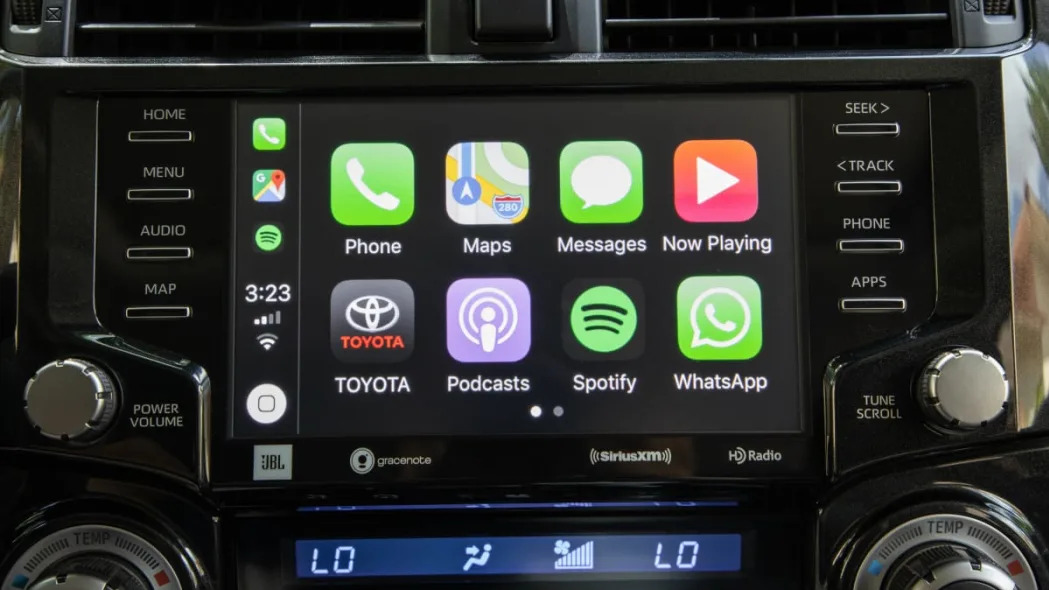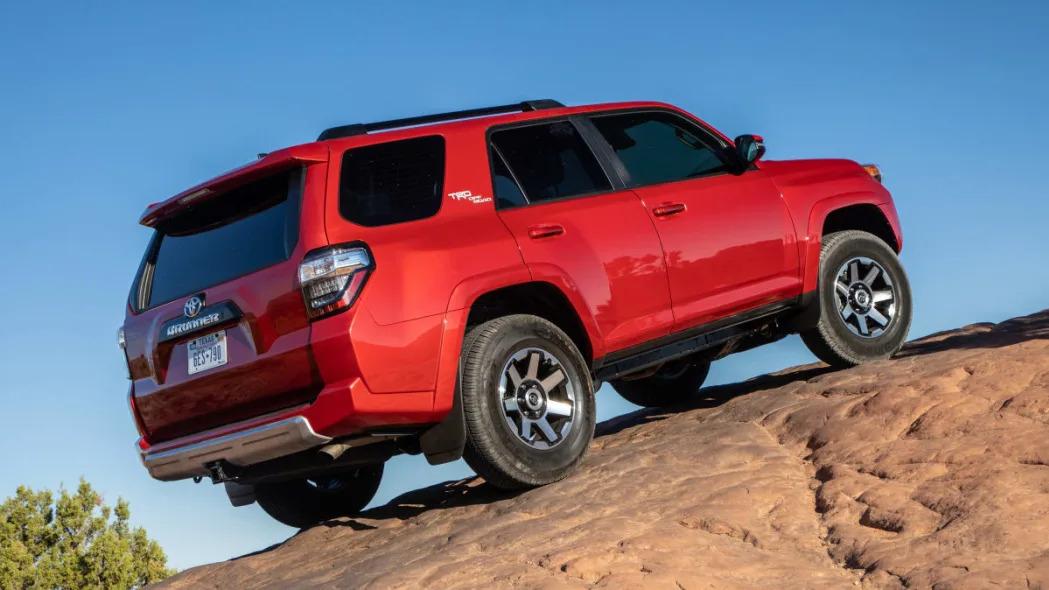-
TrimTRD Off-Road Premium
-
Engine4.0L V6
-
Power270 HP / 278 LB-FT
-
Transmission5-Speed Automatic
-
Drivetrain4WD
-
Curb Weight4,750 LBS
-
Towing5,000 LBS
-
Seating5 (7 w/ optional third-row)
-
Cargo47.2 CU FT (second row up) / 89.7 (second row down)
-
MPG16 CITY / 19 HWY
-
Base Price$43,590
Despite the proliferation of small, efficient crossovers, the 2020 Toyota 4Runner endures with its body-on-frame construction, aged engine and transmission, and traditional part-time four-wheel-drive. It’s one of the last dinosaurs in the age of mammals. And like dinosaurs (or at least those in Jurassic Park), it has drawbacks, but also inherent coolness and appeal for those willing to tame one. And in the 4Runner family, the sweet spot is the TRD Off-Road Premium.
Before digging into the specific trim, we should briefly note that this dinosaur at least gets a shot of botox for 2020, with significant updates and added features. All trim levels now get a standard suite of driver assist and safety features including automatic emergency braking with pedestrian detection, lane-departure warning, automatic high-beam headlights and adaptive cruise control. A larger 8-inch touchscreen infotainment system is also standard and features Apple CarPlay and Android Auto compatibility. That infotainment system is nicer to look at, and even the shortcut buttons around it have been brought up to modern Toyota standards. But it still isn’t as smooth or quick as competitors’ systems, and the graphics and menus still look and feel too much like older, clunkier Toyota systems. But if you use either CarPlay or Android Auto, you won’t have to use the Toyota menus much.
These little tech improvements are welcome, but they leave unaddressed several key areas, particularly the naturally aspirated 4.0-liter V6. The engine doesn’t sound great, nor is it particularly smooth. Its 270 horsepower and 278 pound-feet of torque are just adequate, and it returns a terrible combined fuel economy rating of 17 mpg. Even a manual-transmission Wrangler with the carry-over V6 engine and no fancy stop-start system gets better fuel economy than this. Part of the blame goes to the 4Runner's automatic transmission, which has just five gear ratios to work with. It can’t have too high a top gear, and it can’t keep its rpm in a more efficient range. It is at least smooth, and it doesn’t restlessly shift from gear to gear like transmissions with more cogs, but it also frequently can’t downshift to get the most out of the old engine.
The rest of the oily bits go unchanged as well, but that's generally for the better. The 4Runner still rides smoothly and is quiet. In corners, our tester didn't have as much body roll as one might expect, being fairly indicative of what would be found in a softly sprung sedan. This is probably due to the optional electronically adjustable suspension. The steering is responsive, too, but vague. The 4Runner is easy to maneuver thanks to its relatively small dimensions and good visibility. And of course, it offers impressive off-road capability with good ground clearance, a selectable four-wheel-drive system, and available features such as a rear differential lock and low-speed off-road cruise control called Crawl Control.
Inside, the 4Runner is still as plasticky and chunky as ever, except this year it has gloss black trim across the board instead of metallic-painted plastic. It’s neither an improvement nor a detriment. Climate controls are big, substantial knobs that are easy to use. The driving position is high and upright with lots of room. The 4Runner has an available third row of seats, but they are definitely for children only, and even then only for short trips.
If a 4Runner does appeal to you, particularly for off-roading, you're probably looking at one of the three TRD Off-Road trims: standard, Premium, or TRD Pro. We tested the Premium trim, and it’s a great mix of off-road features and comfort features, all for a reasonable price. Like all TRD Off-Road models, the Premium comes with standard four-wheel drive, skid plates, Crawl Control, locking rear differential and different drive modes for different terrains. Mechanically, it doesn’t differ much from the top-of-the-line TRD Pro. The Pro only adds Fox Racing shocks, a branded aluminum front skid plate, all-terrain tires and a TRD cat-back exhaust as far as functional parts are concerned (but does offer meatier styling and a unique Army Green paint color). And while the Fox shocks aren’t available on the Premium, the Premium can be fitted with electronically adjustable shocks that can make on-road driving nicer while still providing good off-road capability. Also, we can’t recommend the cat-back exhaust, which was added to our test car as an optional accessory. It’s loud and it drones. A neighbor described it as sounding like a lawn mower, and he wasn’t wrong.
So why not just stick with the basic TRD Off-Road? Quite simply, the Premium's extras will make life just that much easier and comfier with its added heated power-adjustable seats, leatherette upholstery, proximity entry and push-button start (another new feature for 2020), an auto-dimming rear-view mirror and an upgraded eight-speaker sound system. They're worth the extra pennies in the car payment. The Premium only costs an extra $1,000 over the base TRD Off-Road despite those worthwhile extras.
Now, in terms of creature comforts, the Premium does lack the Pro's 15-speaker sound system, sunroof and navigation, but the Pro's starting price is $50,885. The TRD Off-Road Premium starts $7,000 cheaper at $43,590. You can also option in the TRD Pro's adaptive suspension and a sunroof (not a great idea since it significantly reduces headroom), still have a few thousand left over, and have most of what makes a TRD Pro so capable off-road.
And the money you save could be used on more off-road-capable tires, suspension upgrades or even to take your 4Runner on a nice outdoorsy vacation. So if you really have your heart set on this highly traditional SUV and its off-road credentials, consider skipping the TRD Pro’s flash for the TRD Off-Road Premium’s value.












Sign in to post
Please sign in to leave a comment.
Continue